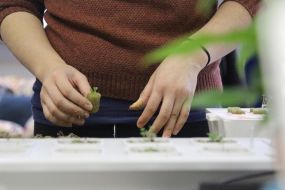They say there’s nothing better than produce that you grow yourself. You can actually taste the difference and the effort you put in to growing these plants makes every bite even more satisfying. For those with limited outdoor space or live in a climate that isn’t conducive to growing their favorite produce, indoor growing is the best option for gardening.
If you are considering indoor growing, you’ve come to the right place. Today we walk through everything, from types of indoor gardens to ideal positioning and how to properly tend to and harvest your plants. We’ll also talk about the latest tech innovations that help you get the most yield for your efforts.
Why Indoor Gardening?
Before we get into the specifics, let’s talk about the advantages of indoor growing. Indoor gardening gives you unparalleled control over your garden. First, you don’t have to worry about animals destroying your plants. Same with the whims of mother nature, like intense rain, rapid changes in temperature and high winds. Finally, you can grow year-round, which is particularly enticing for those who live in colder climes.
Next, depending on your setup, you can also have near-total control over your indoor garden’s environment. Everything from temperature and sunlight to nutrient quality and humidity can be adjusted for maximum effectiveness.
Some indoor gardening setups are also more efficient with space. Some of the latest setups operate more like cabinets, stacking rows of plants on top of one another.
Types of Indoor Gardening
Broadly, there are three major ways that you can grow a lot of plants or produce indoors. Let’s break down each one:
1. Hydroponics: Typically, plants grow in soil that’s watered. Plants soak up water and nutrients through the soil to grow and thrive. Hydroponics cuts out the soil and instead delivers everything the plants need through water exclusively. Hydroponics offers a cleaner, more efficient way of gardening that limits the amount of water used and helps plants grow bigger, faster. Enclosed hydroponics take this one step further and create the perfect environment for your plants inside a clear cabinet-like appliance.
2. Potted plants: Do you have some counter space that you want to use to grow herbs or flowers? Perhaps you want to dedicate an entire room to gardening and use pots to contain the soil. Both of these approaches fall under the “potted plant” category. Probably the most common form of indoor growing, it also has a couple of drawbacks. Namely, it offers the least yield and is arguably one of the more work-intensive forms, depending on your goals and the types of plants.
3. Terrariums: Perfect for plants that need very specific conditions, terrariums are usually reserved for tropical or desert plants. You can use them for other types but, in general, an enclosed hydroponic setup will use less energy and resources while giving you more.
Making the Right Conditions for Indoor Growing
Depending on the scope, size of plants and type of gardening you want to do, you will need a dedicated space to grow plants. If you are dedicated to elaborate potted plants, then you will need a room that has plenty of natural sunlight and it fitted for dealing with the difference in humidity and temperature from the rest of the space. This can be accomplished through humidifiers and dehumidifiers. You will also need a reliable water reservoir, a carbon filter to keep the air clean and an LED system to supplement the natural light. An easy-to-clean floor is also recommended for this approach as well since the ground is likely to get dirty.
If you choose the terrarium or enclosed hydroponic approach, then you will need a lot less. In fact, many of the hydroponic indoor growing systems keep everything safe and contained, letting you enjoy the harvest without the complicated setup.
Getting the right equipment
If you’re serious about growing indoors, then you’ll need the absolute best equipment to help. Depending on your goals, a hydroponic setup will likely be the best route. We recommend that you look at the latest in hydroponic indoor growing systems. The latest systems automate much of the process and can even be set up with subscription services, so you have a steady flow of seeds to grow your garden. That way, you can have a healthy and consistent harvest without worrying about the everyday chores around it.
